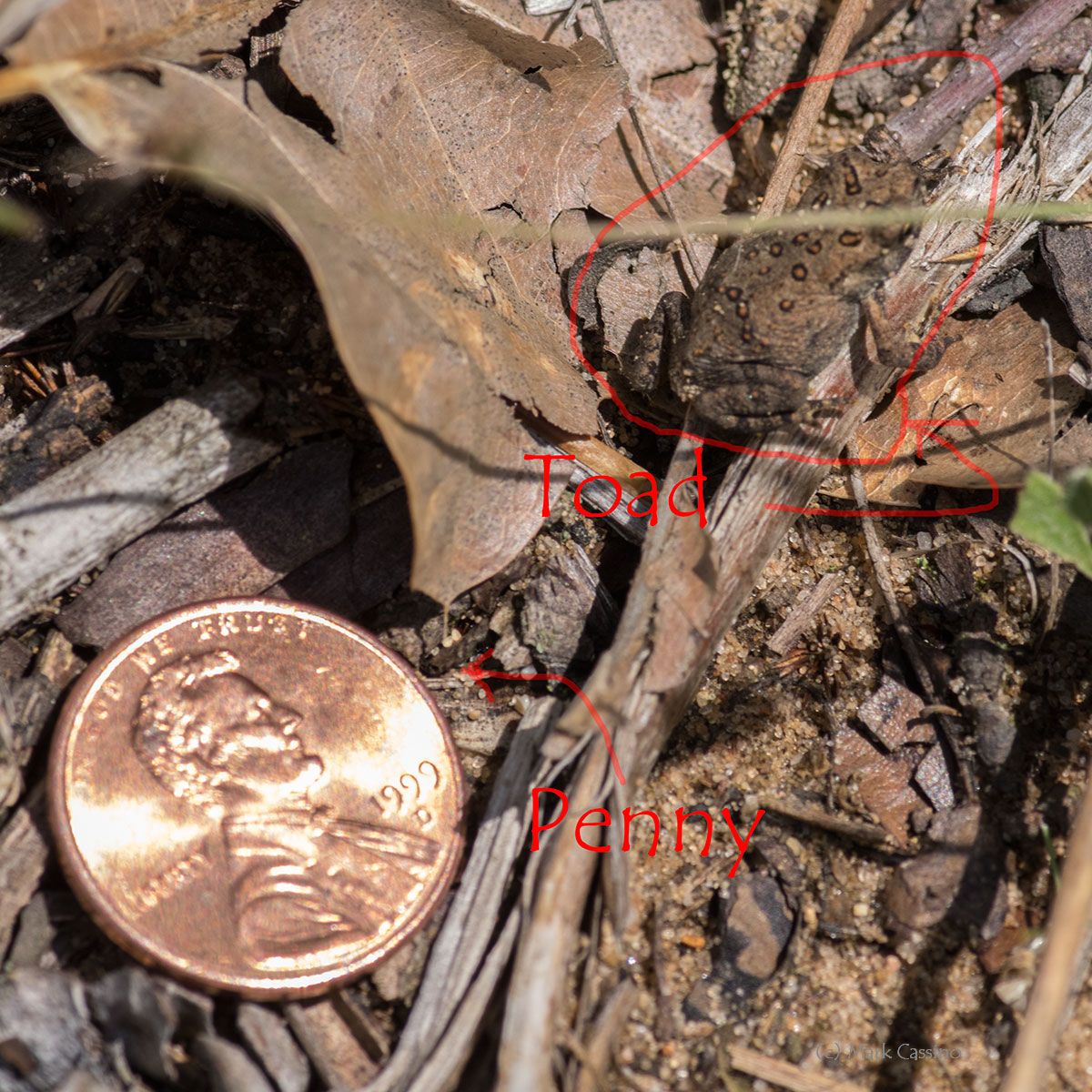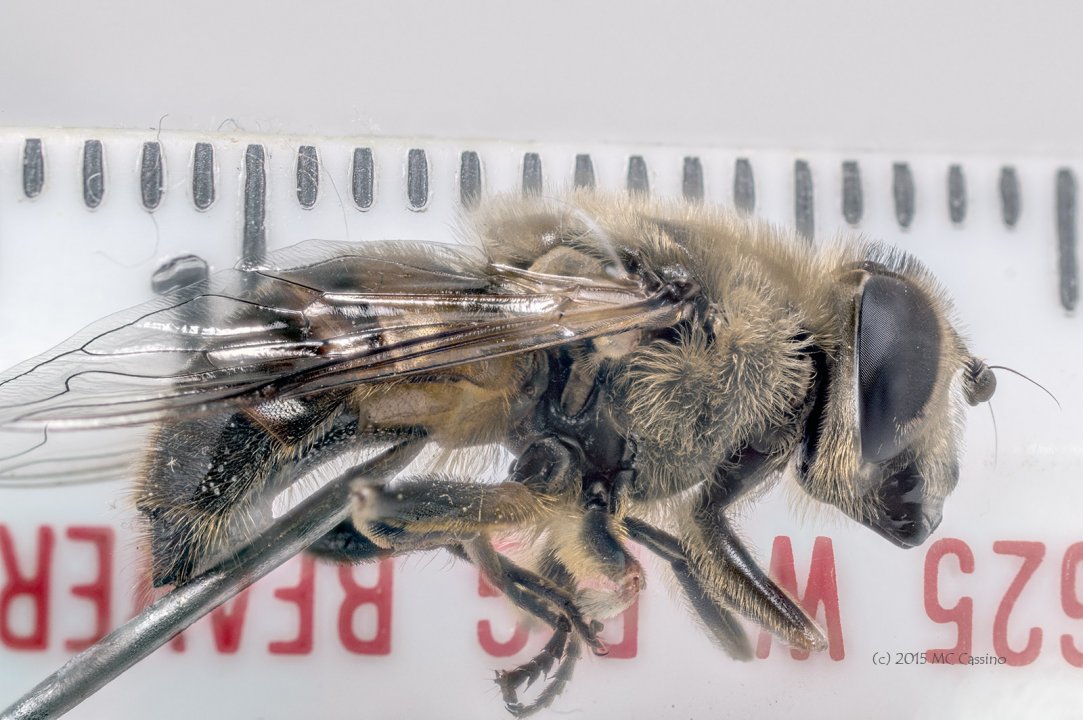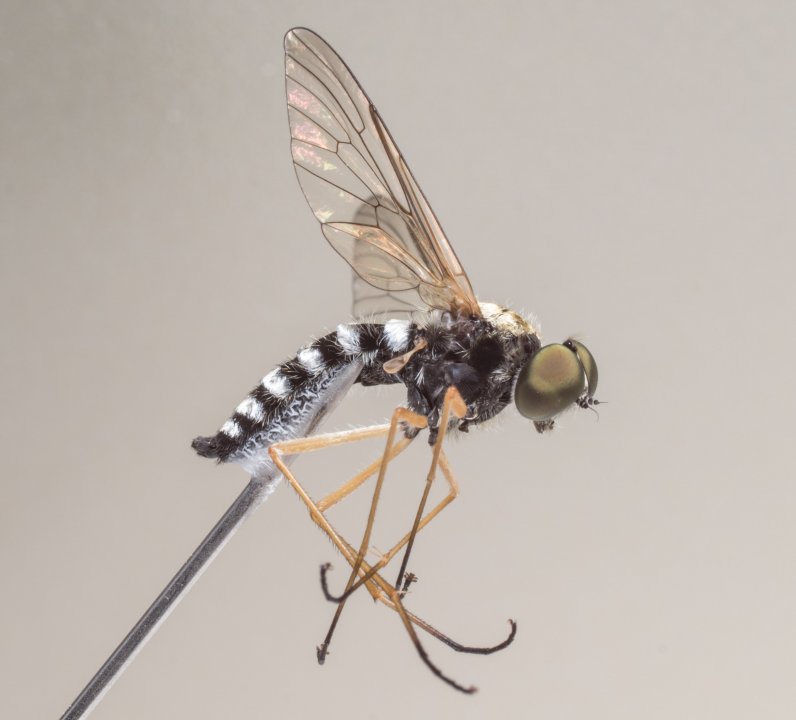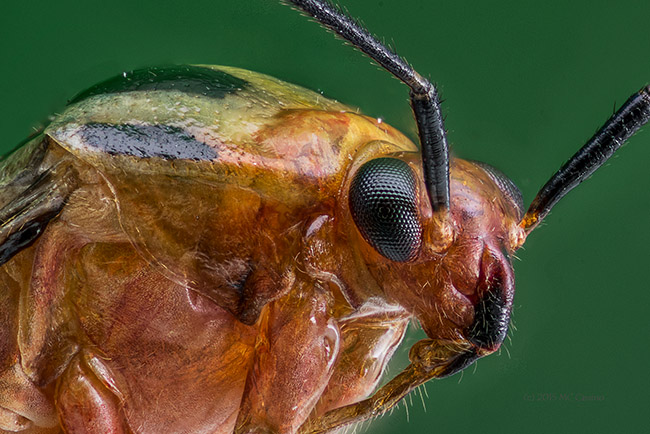Posted by mark on Jun 23 2015 in Insect Photography, Macro Photography, Focus Stacking, Extreme Macro
Archives for: "June 2015"
Posted by mark on Jun 20 2015 in Michigan, Allegan State Game Area, Allegan Forest, Herpetological Photography, Macro Photography
Yesterday I visited a favorite pond in the Allegan Forest. For years I knew the pond as a seasonal marsh which went dry every summer, but over the past decade or so it has steadily filled up with water and no longer goes dry. It is host to an enormous number of dragonflies and also frogs, toads, turtles and more. Periodically, a huge number of these tiny toads flood the grassy savannah near the pond:
This is an Eastern American Toad, Anaxyrus americanus. It was quite small, roughly comparable to a US one cent piece in size. Here is a very crude comparison shot:

The field was teeming with these little toads yesterday, something that happens now and then in late spring or early summer. There were literally thousands of these tiny creatures making their way through the fields and into the adjacent woods.
Posted by mark on Jun 18 2015 in Insect Photography, Macro Photography, Focus Stacking, Extreme Macro
The fireflies (a.k.a. Lightning Bugs) made their appearance here in SW Michigan in the past week or so. Here is a closeup:
Seventy stacked images in two passes. Magnification of approximately 7x lifesized. Pentax K3, SMC K 24mm f3.5 reverse mounted on extension.
I try to make at least one improvement with each of these super macro sessions. In this case I changed how the mounted insect was supported. I had been mounting the insect on a pin and then sticking the pin into a ball of putty. This allowed for easy positioning of the subject, but it could move slightly (specifically - sink slowly) and that has become more apparent at higher magnification. In this case I simply positioned the mounted subject into surgical clamps, which held it tight without the gradual sinking, but made positioning the subject a bit more fiddly. I also used 3 flashes, all manual, for illumination, changing from the two flash setup I had been using.
Posted by mark on Jun 16 2015 in Insect Photography, Focus Stacking, Extreme Macro
Here in Michigan these beetles are often called "June Bugs" in reference to the time of year when they appear. They can be extremely common - this one was on a bag of water soften salt pellets that I bought last week.
I believe this is a scarab beetle in the genus Phyllophag.
This is a total of 141 stacked images, three separate stacks of 52 to 40 images each. The separate stacks were combined in Zerene Stacker and those three outputs were stacked in Photoshop CS6. Magnification was just over 5x lifesized. Pentax K3, SMC K 24 f3.5 reverse mounted on extension.
Posted by mark on Jun 14 2015 in Insect Photography, Focus Stacking, Extreme Macro
Here's a stack focused portrait of a Crane Fly - click on the image for a larger file:
I'm continuing to work on gaining higher magnifications for these macro photos, and realized that I need to use a shorter focal length for higher magnification on manageable extension. I stumbled into a Pentax MC K 24mm f3.5 lens online last week, and snapped it up. It is an old lens (it was only produced from 1975-1977) and has limited compatibility with modern cameras (including all DSLRs and even the later film cameras.) But it has a reputation for outstanding sharpness and resolution, so I crossed my fingers and bought it.
Here's my first test of this lens. This crane fly's head was bigger than I expected, and this image is at 6x to 6.5x magnification. It does not take an excessive amount of extension to achieve that with a reverse mounted 24mm lens, and so working with this subject was not difficult. I'm somewhat surprised that for a lens of this era there is very little chromatic aberration - virtually none.
Initial results from this lens look very promising! In the next few days I hope to work on some higher magnification levels to assess the results.
Made with a Pentax K3, SMC K 24mm f3.5, extension and flash.
Posted by mark on Jun 12 2015 in Insect Photography, Focus Stacking, Extreme Macro
I noticed this fly on the walk leading towards my house. It was making a loud buzzing noise and furtively thrashing on the ground, unable ot fly (despite the wings going like mad) and seemed to be in its death throes. I put in a plastic film canister and then into the freezer. Click on the image for a lager view:
It was fairly large and magnification here is just under 2.5x. I am not sure what the fly is - possibly a Syrphid fly though nothing I look at seems to match up.
Made with a Pentax K3, DFA 50mm f2.8 macro, and extension tubes. 284 stacked images. For this session I experimented with making 2 detailed stacks - 81 and 62 images - and then 4 fairly casual stacks ranging from 50 to just 20 images. This resulted in 6 separate stacks of the subject which were then combined - some were almost complete, others where very banded, but in combination they came together well.
I also tried to improve the background a bit, in this case I picked up a scrap of junk mail with a rather nice graphic on it and stuck it a few inches behind the subject.
Reference image:

Posted by mark on Jun 10 2015 in Insect Photography, Focus Stacking, Extreme Macro
A common snipe fly (Rhagio mystaceus) - as suggested by the name, it is a pretty common insect.
Photo made with Pentax K3, DFA 50mm f2.8 macro lens on extension. Magnification of about 3.5x. 135 stacked images - 5 complete passes at the subject combined to eliminate banding.
Posted by mark on Jun 08 2015 in Insect Photography, Macro Photography, Focus Stacking, Extreme Macro
A few weeks ago, these Four Lined Plant Bugs (Poecilocapsus lineatus) and their smaller nymphs started munching on a patch of feral spearmint that is growing along the side of my yard. More recently they have taken up on of the Gray Coneflower that is one of the core plants in my little wildflower garden. So, I grabbed a few of them to use for photos:
This was a real bear to photograph! I worked through a few specimens over the course of several days, experimenting with different optics, lighting setups and stacking / post processing techniques. Having multiple identical subjects allowed me to take the time to systematically work through various alternatives - though this subject was a little far gone in this final stack.
This was taken at roughly 5.5x lifesized. I worked through a few specimens and initially tried a couple different 28mm lenses reverse mounted on extension tubes. I first tired an older Ricoh XR Rikenon 28mm f2.8 and then a Pentax SMC A 28mm f2.8. In both cases, the optical quality was good but not excellent. I then switched over to using a reverse mounted Pentax DFA 50mm f2.8 and increased the extension by adding a bellows to the tubes. Obviously, I had to double the extension to get comparable magnification, and so the setup (close to 300 mm of extension) was pretty awkward to work with, but not as bad as I expected. Illuminating the subject purely by flash helped minimize any motion blur that was taking place.
The insect's very shiny wings were another challenge - the first several photographs had intense hot spots on those shiny wings. These were finally tamed by filtering the flash first through a DIY diffuser (a slightly opaque sheet of plastic) a few inches from the flash head and then through a sheet of copier paper. The second flash, used for fill, was bounced off a piece of 8 x 10 mat board. The main flash was above the subject, slightly to the right and the fill light was slightly below the subject and hard to the right.
This subject was over 48 hours old by the time I made the switch to the 50mm lens, and just as I was starting the first stack a slight nudge of the now dried insect resulted in the front legs falling off, leaving only the first leg segment attached to the body. I was pretty tired of this bug by then and just continued shooting, but have cropped the image by about 30% to hide the missing legs and also some of the edge artifacts from the stacking process. There are other signs of wear on the specimen as well.
All in all this was a lot of work with a subject that seemed to grow less interesting with each passing hour - but I learned some new things that hopefully will be put to good use with other subjects in the future.
This final image was made with a Pentax K3, DFA 50mm f2.8 macro reverse mounted on on approximately 300mm of extension. 55 stacked images - Zerene Stacker, PMax and DMap methods blended and retouched in Photoshop CS6.
Posted by mark on Jun 06 2015 in Insect Photography, Macro Photography, Focus Stacking, Extreme Macro
Posted by mark on Jun 03 2015 in Insect Photography, Macro Photography, Focus Stacking, Extreme Macro
Aside from its impressive eyes, this Snipe Fly had stiking silver and black bands along its abdomen - click on the image for a larger view:
I would tentatively identify this as an Ornate Snipe Fly, Chrysopilus ornatus. About 3.5x clifesized, 162 stacked exposures. Pentax K-3 with DFA 50mm macro reverse mounted on extension.
Reference image:

Posted by mark on Jun 02 2015 in Insect Photography, Focus Stacking, Extreme Macro
An Ermine Moth (family Yponomeutidae). These moths get their name from their resemblance of their white fur to ermine, the white fur worn by aristocrats. Ermine is the winter fur of a stoat, which is a kind of weasel.
I really wanted to get more detail in the eyes, but they seem to just drink up all of the light that shines into them.










